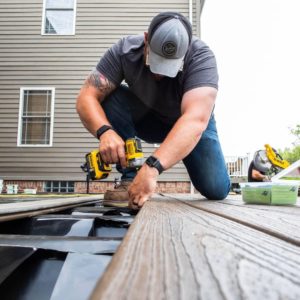How Many Screws Do You Need Per Deck Board?
By Dave KileWhen you’re building or renovating a deck, one detail that is rarely an immediate focus is how many screws you’ll need to secure your decking boards. While it’s not the first thing most homeowners think about, it’s important to get the screw count right. Too few screws, the wrong type, or improper placement can lead to loose, warped, or twisted boards later on.
So, How Many Screws Do You Need?
 The general rule is two screws per joist for most decking boards. For example, if you’re installing a 3.6-metre board and your joists are spaced 450mm apart, you’ll need about 16 screws per board.
The general rule is two screws per joist for most decking boards. For example, if you’re installing a 3.6-metre board and your joists are spaced 450mm apart, you’ll need about 16 screws per board.
In this article, I’ll break down what screws to use, how many you’ll need, and share my practical tips for installation. By the end, you’ll have a clear plan for properly securing your boards to create a strong, long-lasting decking surface.
What Screws Should You Use?
 For timber decks, stainless steel screws are a must—particularly near the coast where corrosion is a risk. Stainless steel resists rust and corrosion, ensuring that your decking stays intact for years to come.
For timber decks, stainless steel screws are a must—particularly near the coast where corrosion is a risk. Stainless steel resists rust and corrosion, ensuring that your decking stays intact for years to come.
If you’re working with composite materials like Trex decking, you’ll want to use composite deck screws. These screws are designed to prevent the “mushrooming” effect, where the composite material pushes up around the screw head, leaving an uneven surface.
Depending on your deck aesthetic, visible screw heads may contribute to the overall look, but most of my deck owners prefer to minimise screw visibility. Whether you’re using timber or composite, you can choose colour-matched screws to camouflage your fasteners. Alternatively, you can countersink your screws and use matching plugs that blend away into the decking, effectively hiding your fastener sites.
Pro Tip: In Australia’s climate, I recommend Trex Protect to safeguard your joists, rim joists, and bearers from moisture—and protect your screw sites. The butyl-based formula flows around fasteners to seal out water that otherwise seeps into screw holes and causes rot or decay, helping your deck screws hold longer and stronger.
Tips for Installing Screws in Deck Boards
When installing deck screws, placement and spacing are important for durability, as well as appearance if you’re using standard or even colour-matched screws.
Deck Board Screw Placement
 Plan for two deck screws per joist. Align the screws directly over the joist, positioning them across from each other. I caution against staggering your screws: It can produce uneven pressure on the boards, which can lead to warping or twisting over time.
Plan for two deck screws per joist. Align the screws directly over the joist, positioning them across from each other. I caution against staggering your screws: It can produce uneven pressure on the boards, which can lead to warping or twisting over time.
For screw placement, aim for about 20mm from the edge. This helps prevent splitting while ensuring a strong, secure hold. Keeping the screws evenly spaced along the length of each board also gives a professional, finished appearance, especially if you’re not using plugs.
If you’re not comfortable eyeballing the screw placement, I recommend using a simple jig or spacer tool to help maintain consistent screw spacing and alignment.
Predrilling Screw Holes
I suggest predrilling pilot holes for your screws—particularly if you’re working with hardwoods—with a drill bit that matches the screw shank diameter minus the threads. This step makes driving screws easier and reduces the risk of splitting, saving you a lot of potential frustration during decking installation.
Some screws are designed to install without predrilling. If you choose self-drilling screws, I recommend driving in a few test screws to make sure you’re happy with the result before taking on your decking surface. Even then, be aware that dense hardwoods can still be challenging to secure without predrilling.
Special Cases
In certain situations, you’ll end up using more screws while adhering to the “two screws per joist” rule:
- Narrower decking boards: Tighter joist spacing may require more total screws.
- Thicker or denser decking materials: Additional screws may be needed to ensure each board is securely fastened.
- Special deck patterns: Diagonals or herringbone layouts and as well as inlays increase the number of screws, as your boards will cross over joists more frequently.
Nailing the Perfect Screw Count
Getting the right number of screws per deck board isn’t complicated, but it does require attention to detail. For most decking projects, two screws per joist are the rule, and you should choose screws based on your material—stainless steel for timber and specialized screws for composite decking. As you install, be sure to follow the spacing guidelines and take your time to ensure your screws are aligned properly. Ultimately, the care you put into securing your deck boards pays off with a reliable, safe, and attractive outdoor space.